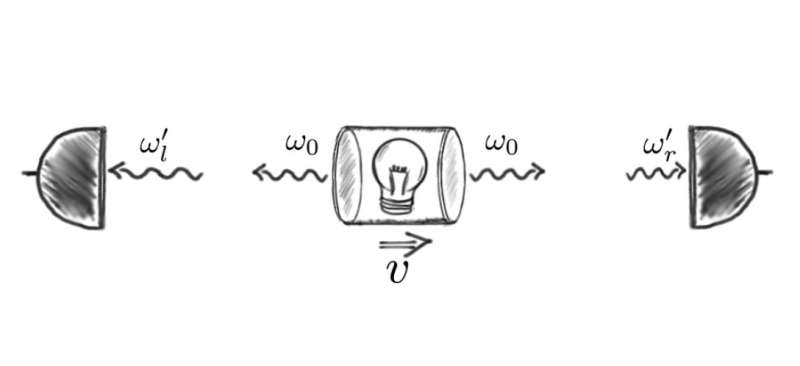February 20, 2017 feature
Friction in the vacuum?

(Phys.org)—When three physicists first discovered through their calculations that a decaying atom moving through the vacuum experiences a friction-like force, they were highly suspicious. The results seemed to go against the laws of physics: The vacuum, by definition, is completely empty space and does not exert friction on objects within it. Further, if true, the results would contradict the principle of relativity, since they would imply that observers in two different reference frames would see the atom moving at different speeds (most observers would see the atom slow down due to friction, but an observer moving with the atom would not).
Writing in Physical Review Letters, physicists Matthias Sonnleitner, Nils Trautmann, and Stephen M. Barnett at the University of Glasgow knew something must be wrong, but at first they weren't sure what.
"We spent ages searching for the mistake in the calculation and spent even more time exploring other strange effects until we found this (rather simple) solution," Sonnleitner told Phys.org.
The physicists eventually realized that the missing puzzle piece was a tiny bit of extra mass called the "mass defect"—an amount so tiny that it has never been measured in this context. This is the mass in Einstein's famous equation E = mc2, which describes the amount of energy required to break up the nucleus of an atom into its protons and neutrons. This energy, called the "internal binding energy," is regularly accounted for in nuclear physics, which deals with larger binding energies, but is typically considered negligible in the context of atom optics (the field here) because of the much lower energies.
This subtle but important detail allowed the researchers to paint a very different picture of what was going on. As a decaying atom moves through the vacuum, it really does experience some kind of force resembling friction. But a true friction force would cause the atom to slow down, and this is not what's happening.
What's really happening is that, since the moving atom loses a tiny bit of mass as it decays, it loses momentum, not velocity. To explain in more detail: Although the vacuum is empty and does not exert any forces on the atom, it still interacts with the atom, and this interaction causes the excited atom to decay. As the moving atom decays to a lower energy state, it emits photons, causing it to lose a little bit of energy corresponding to a certain amount of mass. Since momentum is the product of mass and velocity, the decrease in mass causes the atom to lose a little bit of momentum, just as expected according to the conservation of energy and momentum in special relativity. So while the atom's mass (energy) and momentum decrease, its velocity remains constant.
This picture resolves both of the earlier problems: There are no forces acting between the vacuum and the atom, and two observers in different reference frames would both see the atom moving at the same constant speed, even though the atom would lose momentum due to decaying.
"In principle, the physics underlying our work has been known for a long time, so our result is of rather conceptual importance: We showed that the very successful model generally used to describe the interaction between atoms and light can give this strange friction-like change in momentum," Sonnleitner said. "This result can only be explained when we include the equivalence between mass and energy. But since one would not expect that this aspect of special relativity (E = mc2) actually plays a role in atom-light interactions at these low energies, this has not been included in the model. So this puzzle showed how some piece of special relativity unexpectedly enters a well-studied and very successful model from (non-relativistic) quantum optics."
The effect is probably the first time that an atom's internal binding energy has made such a significant difference in a quantum optical context. The physicists emphasize that the effect is not limited to the spontaneous emission of a photon, but that it occurs whenever an atom changes its internal energy, such as when emitting or absorbing a photon. But in these cases, the atom will also see real velocity-dependent forces, which would hide the effect discussed here. For the time being, experimentally measuring the effect is not likely, since the energy involved is roughly three orders of magnitude smaller than what can be detected by today's most precise measurement techniques.
In the future, the researchers plan to investigate what impact this effect may have on the conventional model of atom-light interactions.
"We will try to extend the successful model currently used to describe atom-light interactions to include the possibility of a changing mass," Sonnleitner said. "Of course this will only be a rather small correction, but it should help to complete the picture. It is never wrong to revisit, rethink and, if necessary, tweak an established theory."
More information: Matthias Sonnleitner et al. "Will a Decaying Atom Feel a Friction Force?" Physical Review Letters. DOI: 10.1103/PhysRevLett.118.053601
Journal information: Physical Review Letters
© 2017 Phys.org



















